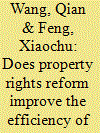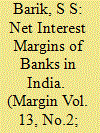| Srl | Item |
| 1 |
ID:
183486


|
|
|
|
|
| Summary/Abstract |
The agriculture sector in India is marred with several problems, which have resulted in farmers’ distress. To address the distress of the farmers, both Central and State Governments of India implemented agricultural debt waiver schemes (ADWRSs) as major policy interventions in recent years. These schemes differ in terms of coverage of the farmers and lending agencies. However, all of them aim to benefit millions of small and marginal farmers of India. The implication and evaluation of these schemes has invited serious criticisms from both policy makers and researchers. It is true that these schemes have created fiscal pressure on the implementing governments. In addition, some degree of corruption has become an integral part of the schemes. However, given the extent of the indebtedness of the farmers, waivers may also be crucial as a temporary measure to mitigate agricultural distress. This paper explores the debate and examines the criticism of the ADWRSs from various quarters. We have found that the majority of arguments against the debt waiver schemes widely accepted amongst bankers, policy makers and even economists are based on perceptions and are not backed by sound economic logic and analysis.
|
|
|
|
|
|
|
|
|
|
|
|
|
|
|
|
| 2 |
ID:
133266


|
|
|
|
|
| Publication |
2014.
|
| Summary/Abstract |
China's state-owned banks have undergone radical changes over the past two decades, including partial privatization and listing in both the Hong Kong Stock Exchange and the Shanghai Stock Exchange. This paper evaluates the effects of these changes by analyzing the efficiency of Chinese banks over the period 1998-2012 using two frontier techniques and comparative analysis. The findings suggest that the performance and technical efficiency of the Big Four banks improved considerably after property rights reform, but this improvement is not sufficient to keep the banks at the production frontier. Tobit regressions confirm that static ownership effects are negative but that the property rights reform has had significant and positive effects on the technical efficiency of state-owned commercial banks. GDP growth and the financial crisis have had positive effects on the efficiency of Chinese banks, which is more significant for joint stock commercial banks than state-owned commercial banks. The results indicate the value of ownership reforms of state-owned asset management companies and insurance companies and the establishment of a countercyclical capital buffer.
|
|
|
|
|
|
|
|
|
|
|
|
|
|
|
|
| 3 |
ID:
164423


|
|
|
|
|
| Summary/Abstract |
Net interest margin (NIM) is the raison d’être of banking. It is an important measure of efficacy of the banking sector. At the system level, it is indicative of the cost of financial intermediation, health of the banking sector and its pricing power. In recent years, the Indian banking sector has experienced a major metamorphosis, with increasing competition and changing norms of liquidity, income recognition and capital. The end of regulatory forbearance and asset quality review (AQR) unearthed significant non-performing assets. This article traces the influence of various factors on the NIM, using bank-level data for 42 Indian banks over 25 quarters from March 2011 to March 2017. The study employs a dynamic panel generalised method of moments (GMM) framework to trace the impact of three distinct set of factors in setting banks’ NIMs: bank-level factors (like the share of low interest-bearing deposits held, the extent of gross non-performing assets [GNPAs], the capital-to-risk weighted assets ratio [CRAR], size of the loan book, operating costs and lending rates); system-level factors such as the monetary policy rate, credit growth and yields on government securities and macro-variables such as GDP growth and inflation. The results indicate that the main determinants of NIMs are banks’ CRAR levels, the proportion of current account and savings account deposits (CASA) to total deposits, operating costs and size of the loan book. Macro-factors like the growth of the economy and repo rate have a positive influence on the NIM.
|
|
|
|
|
|
|
|
|
|
|
|
|
|
|
|
| 4 |
ID:
131246


|
|
|
|
|
| Publication |
2014.
|
| Summary/Abstract |
The Self-Help Group-Bank Linkage Programme (SHG-BLP) was designed with the objective of bridging the prevailing gap in the financial network and spreading banking facilities to the poor in rural and urban areas. This paper examines the progress of SHG-BLP over the last two decades in terms of: (a) the outreach of SHG-BLP; (b) spatial disparity in SHG-BLP; (c) SHG spread with respect to banking and socio-economic indicators; and (d) potential vis-à-vis achievement under the programme in terms of coverage of rural poor population.
|
|
|
|
|
|
|
|
|
|
|
|
|
|
|
|